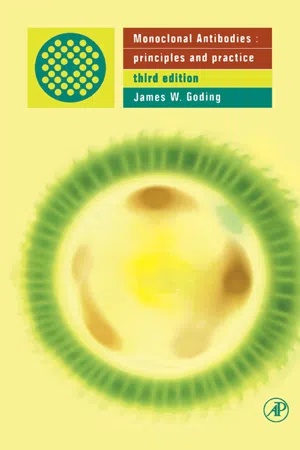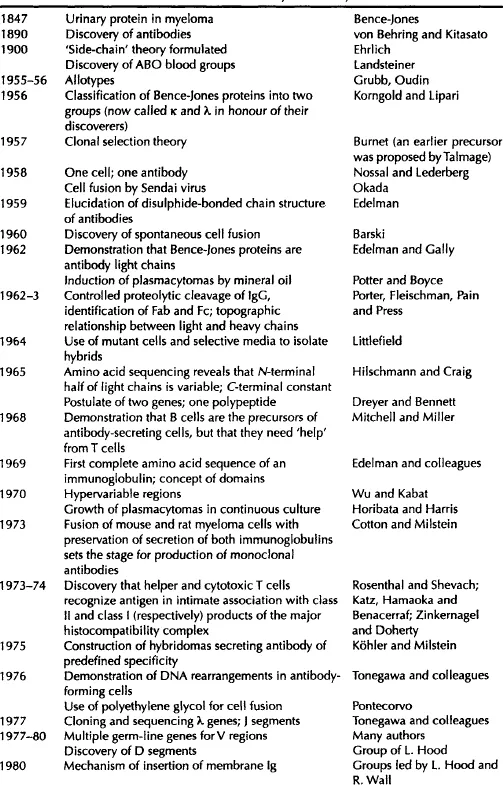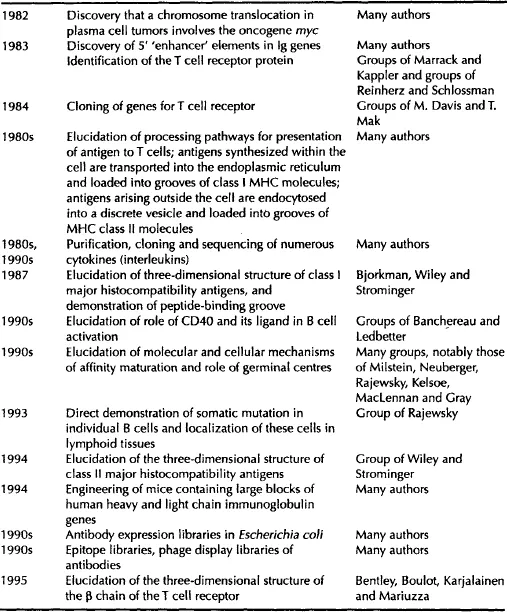
- 492 pages
- English
- ePUB (mobile friendly)
- Available on iOS & Android
eBook - ePub
About this book
Monoclonal Antibodies now have applications in virtually all areas of biology and medicine, and much of the world's biotechnology industry has its foundations in the exploitation of this technology.
The Third Edition of this well established book meets the needs of both newcomers to the area and experienced researchers, by providing an integrated treatment of both the production and application of monoclonal antibodies. As in previous editions, detailed and critical accounts of the theory, production, purification, fragmentation, storage and radiolabelling of monoclonal antibodies are given, along with descriptions of their use in antigen characterization, affinity chromatography and immunofluorescence. The present volume has been comprehensively updated to cover recent rapid advances, particularly with respect to the applications of molecular biology, the use of antibodies in closing and heterologous expression of genes, immunohistology and phage display libraries. Since the previous edition, there has been a growing trend towards the replacement of procedures using radioactive isotopes, and the current edition incorporates these newer technologies.
The text is oriented towards problems solving, and makes it easy to adapt each procedure to individual needs. Extensive cross-referencing, a glossary and a comprehensive index make this book an essential reference.
This book will be vital both for laboratories already producing or using monoclonal antibodies, and for workers in many disciplines who are contemplating their use.
- Provides an integrated treatment of both the production and application of monoclonals in cell biology, biochemistry, and immunology
- Gives detailed and critical accounts of the theory, production, purification, storage, and relabelling of monoclonals, and their use in antigen characterization, affinity chromorography, and immunofluroscence
- Comprehensively updated to cover the rapid advances that have occurred since the publication of the Second Edition
Frequently asked questions
Yes, you can cancel anytime from the Subscription tab in your account settings on the Perlego website. Your subscription will stay active until the end of your current billing period. Learn how to cancel your subscription.
At the moment all of our mobile-responsive ePub books are available to download via the app. Most of our PDFs are also available to download and we're working on making the final remaining ones downloadable now. Learn more here.
Perlego offers two plans: Essential and Complete
- Essential is ideal for learners and professionals who enjoy exploring a wide range of subjects. Access the Essential Library with 800,000+ trusted titles and best-sellers across business, personal growth, and the humanities. Includes unlimited reading time and Standard Read Aloud voice.
- Complete: Perfect for advanced learners and researchers needing full, unrestricted access. Unlock 1.4M+ books across hundreds of subjects, including academic and specialized titles. The Complete Plan also includes advanced features like Premium Read Aloud and Research Assistant.
We are an online textbook subscription service, where you can get access to an entire online library for less than the price of a single book per month. With over 1 million books across 1000+ topics, we’ve got you covered! Learn more here.
Look out for the read-aloud symbol on your next book to see if you can listen to it. The read-aloud tool reads text aloud for you, highlighting the text as it is being read. You can pause it, speed it up and slow it down. Learn more here.
Yes! You can use the Perlego app on both iOS or Android devices to read anytime, anywhere — even offline. Perfect for commutes or when you’re on the go.
Please note we cannot support devices running on iOS 13 and Android 7 or earlier. Learn more about using the app.
Please note we cannot support devices running on iOS 13 and Android 7 or earlier. Learn more about using the app.
Yes, you can access Monoclonal Antibodies by James W. Goding in PDF and/or ePUB format, as well as other popular books in Biological Sciences & Biochemistry. We have over one million books available in our catalogue for you to explore.
Information
1
Introduction
Genetic engineering is now a mature field. It is possible to study, control and manipulate genes in ways that continue to amaze even those working in the field. The power of the tools that have become available has resulted in an explosion of discoveries. The development of a technique for the production of monoclonal antibodies has been an integral part of this revolution. By combining the nuclei of normal antibody-forming cells with those of their malignant counterparts, Köhler and Milstein (1975) developed an unprecedentedly powerful way of analysing and purifying individual molecules within the enormously complex mixtures encountered in biological material. They were awarded the Nobel Prize in Physiology and Medicine for this work in 1984.
Monoclonal antibodies have had revolutionary consequences in biological research and clinical medicine, and have resulted in the generation of an industry with an economic impact measured in billions of dollars (Chien and Silverstein, 1993). It should be emphasized, for the benefit of those who believe that science should be planned to produce economically useful outcomes, that monoclonal antibodies were the result of basic research into the mechanism of generation of antibody diversity. It had no practical application in mind and, indeed, it took some time before the full scientific and economic impact was appreciated, even by the inventors of the technique (see Milstein, 1980, 1986; Melchers, 1995).
Köhler and Milstein’s monumental achievement was the culmination of many seemingly unrelated discoveries by other workers (Tables 1.1 and 1.2; Silverstein, 1989; Gallagher et al., 1995). Of particular importance were the proof of the clonal selection theory (Nossal and Lederberg, 1958), the development of cell fusion techniques (Okada, 1962; Littlefield, 1964), the artificial induction of plasmacytomas (Potter and Boyce, 1962) and their adaptation to tissue culture (Horibata and Harris, 1970). Finally, the demonstration that it was possible to fuse two different plasma cell tumour lines with retention of both antibody products (Cotton and Milstein, 1973) paved the way for subsequent developments.
Table 1.1
Landmarks in the history of antibody research


For further information, see Silverstein (1989) and Gallagher et al. (1995).
Table 1.2
Selected Nobel prizes in immunology
| Year | Recipient | Discovery |
| 1901 | E. von Behring | Serum therapy (antibodies) |
| 1908 | P. Ehrlich and E. Metchnikoff | Work on immunity |
| 1919 | J. Bordet | Discoveries relating to immunity |
| 1930 | K. Landsteiner | Human blood groups |
| 1960 | F. M. Burnet and P. B. Medawar | Acquired immunological tolerance |
| 1972 | G. M. Edelman and R. R. Porter | Chemical structure of antibodies |
| 1977 | R. Yalow, R. Guillemin and R. Schally | Radioimmunoassay (Yalow) and discovery of peptide hormones in the brain |
| 1980 | B. Benacerraf, J. Dausset and G. Snell | Histocompatibility antigens |
| 1984 | C. Milstein, G. Köhler and N. Jerne | Monoclonal antibodies (Milstein and Köhler); theoretical contributions (Jerne) |
| 1987 | S. Tonegawa | Mechanism of action of antibody genes |
In order to appreciate the revolutionary impact of monoclonal antibodies, it is necessary to understand the problems and limitations of conventional serology. Suffice it to say that prior to 1975, the production of antibodies was considered by some to be a black art practised by immunologists. While the specificity of antibodies provided a way of overcoming the enormous complexity of biological material, the production of highly specific antisera was difficult and unreliable. It required highly purified antigen. The uncertainties about the specificity of individual antisera led to many prolonged and acrimonious debates. All that has now changed. It is now possible to produce unlimited quantities of exquisitely specific antibodies against virtually any molecule, regardless of the purity of the immunizing antigen. The fine specificity, degree of cross-reaction, affinity and physical properties of antibodies may be selected to suit individual needs.
It would be wrong to think that monoclonal antibodies will completely replace conventional serology. The production of monoclonal antibodies involves a great deal of work and a high level of commitment. There will often be occasions when the effort may not be justified. Fortunately, a wide range of monoclonal antibodies is becoming available commercially. Polyclonal antibodies may be preferred when the antigen to be recognized is denatured or altered in some other way. It would be unwise to use monoclonal antibodies for the detection of molecules in genetically diverse species without thorough testing to ensure that some molecules do not escape detection owing to genetic polymorphism. For all these reasons, the book concludes with a chapter on the production of conventional antibodies.
I have written this book because I believe that previous accounts of the production, and particularly the usage, of monoclonal antibodies have been too dogmatic and inflexible. ‘Recipes’ have been given which work if followed to the letter, but little attention has been given to the underlying principles. In the real world, one has to adapt each procedure to an individual biological problem.
I have therefore tried to emphasize the important variables that make for success or failure in the use of antibodies, and those points of refinement that allow the capabilities of a system to be pushed to the limit. I have also tried to point out areas in which the literature gives misleading impressions, and a few situations in which published procedures are unreliable.
This book thus represents the distillation and critical evaluation of many hundreds of publications relating to the production and use of antibodies, together with some of my own experience. Immunochemistry also has an oral tradition, and a surprising number of key elements of knowledge are not easily accessible from the literature. I have incorporated some of these elements where appropriate; in many cases no citation is possible.
It is not possible to cover all possible applications of antibodies in one book, nor would it be wise to attempt to do so. I have therefore restricted the book to the ‘core’ techniques of production and handling of antibodies, and their use in studies of antigen analysis, purification and localization. I have tried to avoid techniques that require expensive or specialized equipment. All the techniques described in this book can be carried ou...
Table of contents
- Cover image
- Title page
- Table of Contents
- Dedication
- Copyright
- Preface to First Edition
- Preface to Second Edition
- Preface to Third Edition
- Georges Köhler (1946–1995)
- List of Abbreviations
- Chapter 1: Introduction
- Chapter 2: The Antibody Response
- Chapter 3: Cellular Basis of the Immune System
- Chapter 4: Nature of Antigens
- Chapter 5: Antibody Structure and Function
- Chapter 6: Genetics of Antibodies
- Chapter 7: Introduction to Monoclonal Antibodies
- Chapter 8: Production of Monoclonal Antibodies
- Chapter 9: Purification, Fragmentation and Isotopic Labelling of Monoclonal Antibodies
- Chapter 10: Analysis of Antigens Recognized by Monoclonal Antibodies
- Chapter 11: Affinity Chromatography
- Chapter 12: Immunofluorescence
- Chapter 13: Immunohistology
- Chapter 14: Construction, Screening and Expression of Recombinant Antibodies
- Chapter 15: Generation of Conventional Antibodies
- Glossary
- Index